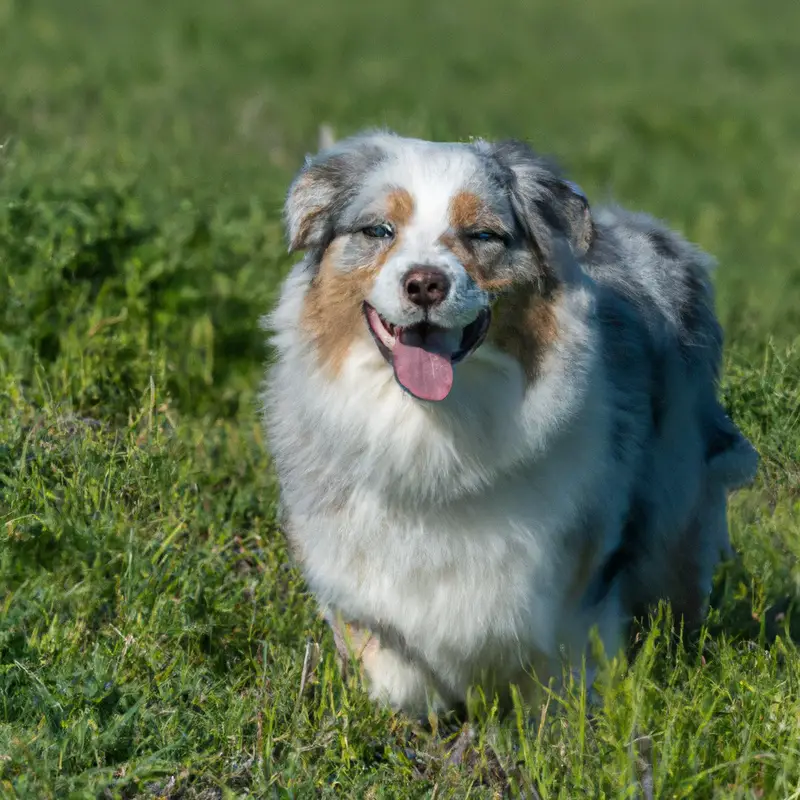How Do Australian Shepherds Handle Being Left Alone In a Crate?
Key Takeaways:
- Australian Shepherds can handle being left alone in a crate if introduced to it properly.
- Crate training is important to help Australian Shepherds feel comfortable and secure when left alone.
- Providing mental and physical stimulation before crating can help reduce anxiety in Australian Shepherds.
- Gradual and positive crate training is key in teaching Australian Shepherds to handle being left alone.
Are you a proud Australian Shepherd owner looking for guidance on crate training? Well, you’ve come to the right place! As an expert in dog behavior and training, I’ve seen firsthand how crate training can benefit this intelligent and energetic breed.
In this article, we’ll explore the importance of crate training for Australian Shepherds and discuss effective strategies to help them handle being alone in a crate.
We’ll dive into the causes and symptoms of separation anxiety, share tips for preparing your pup, and provide insights into creating a positive association with the crate. So, let’s get started and ensure your furry friend feels safe and comfortable while you’re away!
| Behavior | Explanation |
|---|---|
| Australian Shepherds | They are known to be highly adaptable and intelligent dogs. However, they can experience separation anxiety when left alone for extended periods. |
| Crate Training | Proper crate training can help Australian Shepherds feel secure and comfortable in their crate when left alone. It provides a safe space for them and reduces the risk of injury or destructive behavior. |
| Exercise Needs | Australian Shepherds are energetic and require plenty of physical and mental stimulation. Providing adequate exercise before crating can help them settle down and be more content when left alone. |
| Crate Size | It is important to use an appropriately sized crate for an Australian Shepherd. A crate that is too small can make them feel cramped and anxious, while a crate that is too large may not provide a sense of security. |
| Gradual Introductions | Australian Shepherds should be gradually introduced to crate training. Start with short durations and gradually increase the time spent in the crate. This helps prevent anxiety and allows them to develop positive associations with their crate. |
| Distractions | Providing distractions, such as fun and engaging toys or puzzles, can help keep Australian Shepherds occupied and alleviate boredom when left alone in the crate. |
| Socialization | Proper socialization from a young age can help Australian Shepherds develop confidence and independence. This can contribute to them being more comfortable when left alone in a crate. |
| Monitoring | It is important to monitor Australian Shepherds when left alone in a crate, especially during the initial phases of crate training. This allows for early detection of any signs of distress or discomfort. |
Why Crate Training is Important for Australian Shepherds
Benefits of Crate Training for Australian Shepherds
Crate training can offer several benefits for Australian Shepherds.
- Safe and secure space: Crates provide a safe and secure space for your Australian Shepherd when you can’t supervise them. It prevents them from getting into trouble and potentially harming themselves or damaging your home.
- Housetraining aid: Crate training can help in housetraining your Australian Shepherd. Dogs naturally avoid soiling their sleeping area, so the crate can encourage them to hold their bladder and bowel movements until they’re taken outside.
- Reduces separation anxiety: Australian Shepherds are prone to separation anxiety, and crates can help alleviate their stress. Being in a confined space can give them a sense of security and prevent destructive behaviors that often result from anxiety.
- Travel convenience: Crate-trained Australian Shepherds are easier to transport. Whether you’re going on a road trip or flying, having a dog who is comfortable in a crate makes the journey safer and less stressful for both of you.
- Facilitates vet visits: If your Australian Shepherd is accustomed to being in a crate, it can make vet visits less stressful. Many veterinarians use crates during exams and procedures, so crate training will ensure a smoother experience for your furry friend.
Remember, crate training should always be done in a positive and humane manner. It’s important to introduce the crate gradually, use positive reinforcement techniques, and never use the crate as a form of punishment.
Consult a professional dog trainer if you need guidance on crate training your Australian Shepherd.
Establishing a Positive Association with the Crate
To establish a positive association with the crate for your Australian Shepherd, start by introducing the crate as a comfortable and safe space. Place soft bedding and toys inside to make it inviting.
Gradually acclimate your dog to the crate by feeding meals near it and eventually inside it.
Reinforce positive behaviors with treats and praise. Avoid using the crate for punishment or as a way to isolate your dog.
With patience and consistent positive reinforcement, your Australian Shepherd will learn to view the crate as a cozy den and feel calm and secure when spending time inside.
Understanding Separation Anxiety in Australian Shepherds
Causes and Symptoms of Separation Anxiety
Separation anxiety in Australian Shepherds can be triggered by various factors and can manifest through several symptoms. Some common causes of separation anxiety include changes in routine, being left alone for extended periods, or previous traumatic experiences.
Symptoms of separation anxiety may include excessive barking, destructive behavior, urinating or defecating in the house, pacing, and excessive drooling.
It’s essential to recognize these signs and address separation anxiety in Australian Shepherds to ensure their well-being and happiness.
Impact of Separation Anxiety on Australian Shepherds
Separation anxiety can have a significant impact on Australian Shepherds. This condition can lead to distress and behavioral issues when they are left alone.
Some common symptoms of separation anxiety in Australian Shepherds include excessive barking, destructive behavior, and house soiling.
It is important to understand that separation anxiety is not a result of a lack of training or discipline, but rather a deep emotional response to being separated from their owners. The impact of separation anxiety on Australian Shepherds can be detrimental to their overall well-being.
The prolonged stress caused by this condition can result in physical health problems such as loss of appetite, weight loss, and even self-inflicted injuries.
It can also have a negative impact on their mental and emotional state, leading to depression and anxiety disorders. Addressing separation anxiety in Australian Shepherds is crucial to ensuring their happiness and quality of life.
Taking steps to alleviate their anxiety, such as crate training and gradually increasing separation time, can be effective in managing this condition.
Additionally, providing them with engaging toys, creating a calming environment, and establishing a consistent routine can help reduce their anxiety levels. If your Australian Shepherd is experiencing severe separation anxiety, it may be necessary to seek professional help from a veterinarian or a certified dog trainer.
They can provide guidance and recommend appropriate treatment options to address the issue.
Remember, with patience, understanding, and consistent training, it is possible to help Australian Shepherds overcome separation anxiety and lead fulfilling lives.

Preparing Your Australian Shepherd for Crate Time Alone
Incorporating Positive Reinforcement Techniques
When crate training your Australian Shepherd, incorporating positive reinforcement techniques is key to ensure your pup has a positive association with the crate. Here are some effective techniques to try:
- Rewards: Use treats, praise, and affection to reward your dog when they enter the crate willingly or stay calmly inside. This will help them associate the crate with positive experiences.
- Gradual Introductions: Start by leaving the crate door open and allowing your dog to explore the crate at their own pace. Encourage them with treats and praise when they show interest or go inside. Gradually increase the amount of time they spend in the crate.
- Feeding in the Crate: Serve your dog’s meals inside the crate to create a positive association. This will help them view the crate as a safe and enjoyable space.
- Interactive Toys and Treats: Provide engaging toys, puzzle feeders, or long-lasting chews to keep your dog occupied and entertained while in the crate. This can help distract them from any anxiety or boredom they may experience.
- Calm Environment: Set up the crate in a quiet and calm area of your home. Use soothing music or a white noise machine to create a peaceful atmosphere. Avoid sudden loud noises or disruptions that could startle your dog.
Remember, positive reinforcement techniques focus on rewarding desired behaviors and creating a positive experience for your Australian Shepherd. With patience and consistency, your pup will learn to feel comfortable and content in their crate.
Tips to Help Australian Shepherds Cope with Being Alone in a Crate
Providing Engaging Toys and Chewables
To ensure that Australian Shepherds can cope with being alone in a crate, providing engaging toys and chewables is essential. These toys help keep them occupied and mentally stimulated while in the crate, reducing their anxiety and boredom.
Look for toys that are specifically designed for dogs, such as puzzle toys or treat-dispensing toys.
These can keep them entertained and challenge their problem-solving skills. Chewables, such as durable bones or flavored chew toys, are also great for Australian Shepherds.
Chewing helps relieve stress and provides them with an outlet for their natural chewing instincts.
Just make sure to choose toys that are safe for them to chew on and avoid any that are easily destructible or can be swallowed in large pieces. Rotating the toys and chewables regularly can keep them fresh and interesting for your Australian Shepherd.
This way, they won’t get bored with the same toys and will be more engaged while in the crate.
Remember, providing engaging toys and chewables is just one part of helping Australian Shepherds cope with being alone in a crate. It’s important to incorporate other strategies, such as creating a calming environment and establishing a routine, to ensure their overall well-being and comfort when crated.

Creating a Calming Environment
Creating a calming environment is essential in helping Australian Shepherds handle being left alone in a crate. Here are some tips:
- Soft bedding: Provide comfortable bedding inside the crate to create a cozy and inviting space for your Australian Shepherd. This can help them feel secure and relaxed.
- Dim lighting: Keep the environment in the room where the crate is located calm and soothing. Avoid bright lights or direct sunlight that can be stimulating or create anxiety.
- Calming scents: Consider using natural scents, such as lavender or chamomile, to create a relaxing atmosphere. You can use essential oils or scented sprays specifically designed for dogs, but make sure they are safe and non-toxic.
- Background noise: Soft, soothing music or white noise in the background can help drown out any external noises that may cause anxiety or stress for your Australian Shepherd.
- Temperature control: Ensure that the room temperature is comfortable for your dog. Avoid extremes of hot or cold, as they can create discomfort and distract from relaxation.
By creating a calming environment, you can help your Australian Shepherd feel more at ease in their crate and alleviate any stress or anxiety they may experience when left alone.
Implementing a Routine for Crating Australian Shepherds
Establishing Regular Crate Times
Establishing regular crate times is essential for crate training Australian Shepherds. It helps them develop a sense of routine and familiarity with the crate, making them more comfortable and relaxed.
Consistency is key when it comes to crate training, so it’s important to set specific times for crate sessions throughout the day.
To establish regular crate times, start by determining how long your Australian Shepherd can comfortably stay in the crate without getting anxious or distressed. This will vary depending on their age and individual needs.
Gradually increase the duration over time as they become more accustomed to being in the crate.
It’s also important to consider your dog’s daily routine and schedule crate times accordingly. For example, crate them for shorter periods during times when they are naturally more active, such as after a walk or play session.
This will help them associate the crate with relaxation and downtime.
Additionally, consistency in crate times can be beneficial when it comes to potty training. Taking your Australian Shepherd out to relieve themselves at the same times every day can help establish a routine and minimize accidents.
While it’s important to have regular crate times, it’s equally crucial to provide your Australian Shepherd with plenty of exercise, mental stimulation, and social interaction outside of the crate.
Make sure to balance crate time with supervised playtime, training sessions, and walks to keep your dog happy and well-rounded. By establishing regular crate times, you can help your Australian Shepherd become more comfortable and content in their crate, making crate training a positive experience for both of you.
Introducing Scheduled Breaks
Introducing scheduled breaks can be a helpful strategy when crate training Australian Shepherds. It’s important to gradually increase the amount of time your pup spends in the crate, as this will help them become more comfortable and less anxious.
Start by keeping them in the crate for short periods, then gradually extend the duration.
Scheduled breaks allow your Australian Shepherd to stretch, move around, and take bathroom breaks outside of the crate. Just be sure to supervise them during these breaks to prevent accidents or destructive behavior.
Remember, consistency and patience are key when implementing scheduled breaks.

Seeking Professional Help for Severe Separation Anxiety in Australian Shepherds
Recognizing When to Consult a Veterinarian or Trainer
If you’re struggling with your Australian Shepherd’s severe separation anxiety and your efforts to alleviate it aren’t working, it may be time to consult a professional veterinarian or trainer. While it’s normal for Australian Shepherds to experience some level of distress when left alone, severe separation anxiety can significantly impact their well-being and quality of life.
Recognizing the need for professional help is crucial when you notice that your Australian Shepherd’s separation anxiety is worsening or causing extreme behaviors such as excessive barking, destructive chewing, or self-harm.
Additionally, if your dog’s anxiety is negatively affecting your daily routines or causing significant stress for both you and your pet, it’s time to seek guidance from a veterinarian or experienced trainer. Veterinarians can assess your dog’s physical health and provide recommendations for managing and treating separation anxiety.
They may also suggest medication options to help alleviate your Australian Shepherd’s anxiety and improve their overall well-being.
Additionally, trainers specialized in behavioral issues can offer valuable insights, practical strategies, and personalized training plans to help your dog overcome their separation anxiety. Remember, seeking professional assistance does not mean you have failed as a dog owner.
It’s a responsible and compassionate step towards helping your Australian Shepherd live a happier and more balanced life.
With the guidance of a veterinarian or trainer, you can find the right techniques and support to address your dog’s severe separation anxiety effectively.
Potential Treatment Options for Severe Cases
In severe cases of separation anxiety in Australian Shepherds, it may be necessary to seek professional help. Here are some potential treatment options:
- Medication: Your veterinarian may prescribe anti-anxiety medications to help alleviate your Australian Shepherd’s symptoms. These medications can help reduce anxiety levels and make it easier for your dog to cope with being alone.
- Behavior modification: Working with a professional dog trainer or behaviorist can be beneficial in developing a behavior modification plan tailored to your dog’s specific needs. This may involve desensitization and counterconditioning techniques to gradually help your dog become more comfortable with being alone.
- Environmental enrichment: Providing your Australian Shepherd with plenty of mental and physical stimulation can help alleviate anxiety. This can include puzzle toys, food-dispensing toys, interactive play, and regular exercise.
- Desensitization and counterconditioning exercises: These exercises involve gradually exposing your dog to situations that trigger anxiety, such as being left alone, in a controlled and gradual manner. The goal is to help your dog build positive associations and reduce anxiety over time.
- Pheromone therapy: Synthetic pheromones, like Adaptil, can be used to create a calming environment for your Australian Shepherd. These pheromones mimic the natural comforting scents that dogs release, helping to reduce anxiety.
Remember, every dog is unique, and what works for one may not work for another. It’s important to work with a professional to create a personalized treatment plan for your Australian Shepherd’s severe separation anxiety.
With patience, consistency, and the right support, you can help your dog feel more secure and comfortable when left alone.
Gradual Crating Transition: From Crating to Being Left Alone
Phasing Out Crate Time
To phase out crate time for your Australian Shepherd, gradually increase the amount of time they spend outside the crate while ensuring their safety. Start by leaving the crate door open while you’re home, and gradually extend this to short periods of leaving them alone in a safe space.
Monitor their behavior during these transitions and provide plenty of mental and physical stimulation to keep them occupied.
Eventually, your Australian Shepherd should be comfortable being left alone outside of the crate for longer periods of time.
Introducing Free-Roaming in a Safe Space
When it’s time to transition your Australian Shepherd from the crate to being left alone, it’s important to introduce free-roaming in a safe space. Start by designating a specific area of your home that is secure and free of any potential hazards.
Make sure the space is comfortable and has everything your dog needs, such as water, bedding, and toys.
Gradually increase the amount of time your dog spends in this space while you’re away, starting with short periods and gradually working up to longer durations. By providing a safe and familiar environment, your Australian Shepherd can learn to feel comfortable and secure when left alone.
Final Verdict
Crate training plays a crucial role in helping Australian Shepherds cope with being left alone. By establishing a positive association with the crate and gradually introducing crate time, we can alleviate separation anxiety and create a safe and comforting space for our furry friends.
Providing engaging toys, a calming environment, and implementing a routine further enhances their experience.
However, severe cases of separation anxiety may require professional help. Ultimately, by understanding their needs and implementing these strategies, we can ensure that our Australian Shepherds feel secure and content even when left alone in a crate.
Trust in the process and enjoy the peace of mind knowing that you are providing the best care for your four-legged companion.







